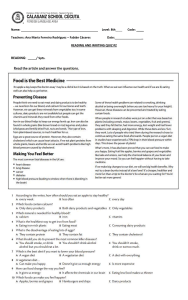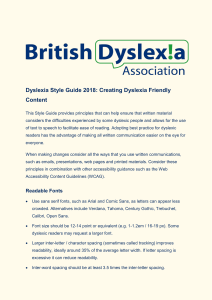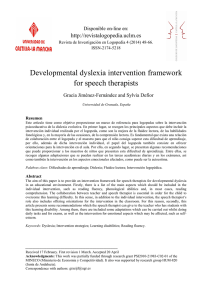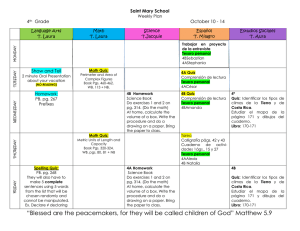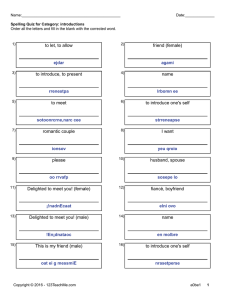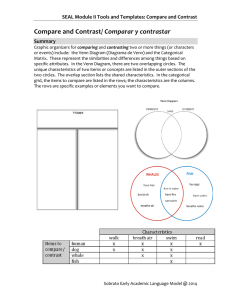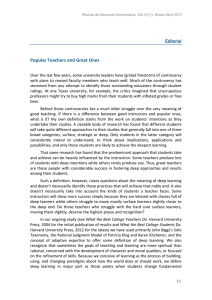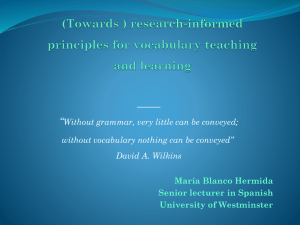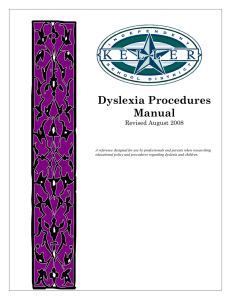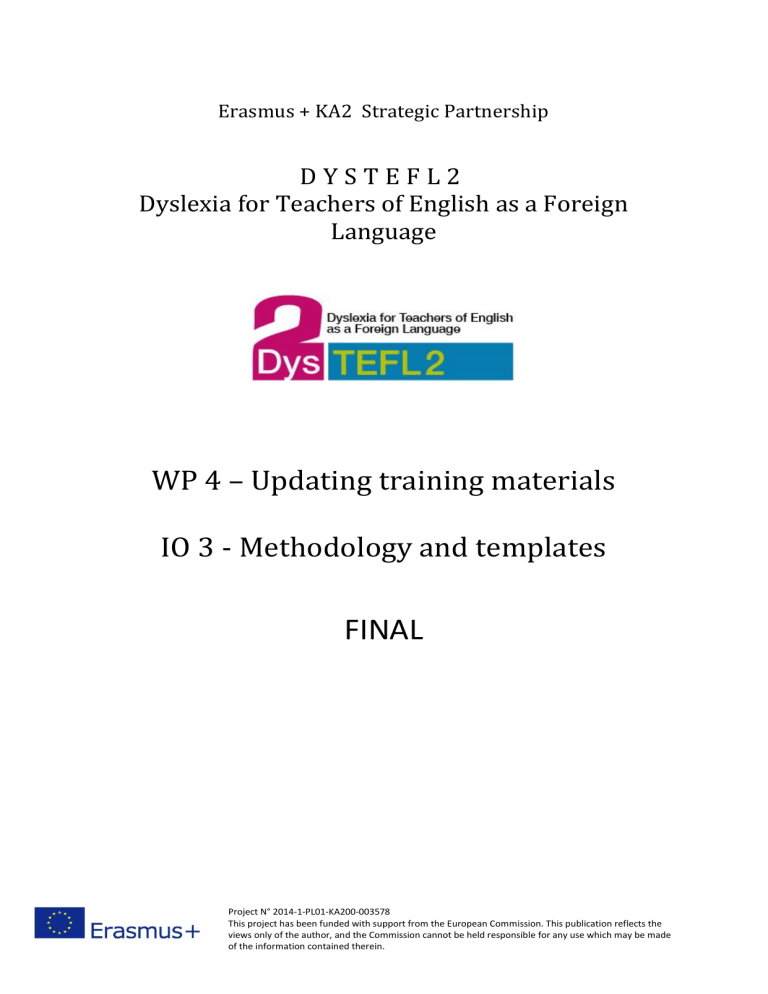
Erasmus + KA2 Strategic Partnership DYSTEFL2 Dyslexia for Teachers of English as a Foreign Language WP 4 – Updating training materials IO 3 - Methodology and templates FINAL Project N° 2014-1-PL01-KA200-003578 This project has been funded with support from the European Commission. This publication reflects the views only of the author, and the Commission cannot be held responsible for any use which may be made of the information contained therein. DysTEFL2 WP4 Methodology and templates INDEX 1. Methodology of WP4 – Updating training materials ...................................................................... 3 1.1 Introduction ............................................................................................................................. 3 1.2 Preparing guidelines for WP4 .................................................................................................. 3 1.3 Designing quiz/test templates................................................................................................. 4 1.4 Updating course materials ...................................................................................................... 4 1.5 Preparing single unit quizzes and whole course test .............................................................. 6 1.6 Scoring procedure for unit quizzes .......................................................................................... 7 2. Templates ........................................................................................................................................ 9 ANNEX 1. The structure of the Dystefl course..................................................................................... 17 Project N° 2014-1-PL01-KA200-003578 This project has been funded with support from the European Commission. This publication [communication] reflects the views only of the author, and the Commission cannot be held responsible for any use which may be made of the information contained therein. DysTEFL2 WP4 Methodology and templates 1. Methodology of WP4 – Updating training materials 1.1 Introduction The DysTEFL teacher development course we intend to popularize in the DysTEFL2 project is innovative and practical in its content, structure and format. It addresses a gap in the field of initial English language teacher training and Continuing Professional Development (CPD) where the needs of students with dyslexia are frequently neglected. It provides both a solid theoretical foundation about the nature of dyslexia and practical suggestions for classroom teaching, task and curriculum design, and assessment. The course is unique in its focus on language learners with dyslexia, in its approach to teacher training and CPD in providing freely downloadable booklets and a complete set of self-study materials. An important innovative feature of the course is that it takes a task-based approach to teacher development and employs tasks to enhance learning and reflection. New ideas and relevant background information are presented using the innovative means made available by modern technology (e.g. You-tube videos, webpages, web links, podcasts and screencasts). We intend to update and complement the existing DysTEFL course materials in two ways. We will focus on developing a battery of quizzes/tests (for each course unit and the whole course with regards to each mode of the course: face-to-face, on-line self-study and distance learning - Moodle), this constitutes an integral part of the procedures for confirming/validating learning outcomes. In addition, we will also substitute/change/incorporate new materials where necessary to enhance the quality of the course. Summing up, the WP4 involves updating and complementing the existing DysTEFL course materials and entails the following steps: (1) Preparing guidelines (specifying the sequence of steps - the method, the process and the activities to be realised by all project partners) and tools (templates for single unit quiz and whole course test as well as templates for DyTEFL2 training and dissemination events certificates), (2) Substituting/changing/incorporating new materials where necessary to enhance the quality of the course in each mode of the course: face-to-face, on-line self-study and distance learning - Moodle, (3) Developing a battery of quizzes for each course unit and the whole course test in each mode of the course: face-to-face, on-line self-study and distance learning - Moodle. 1.2 Preparing guidelines for WP4 The guidelines specify the sequence of steps - the method, the process, the activities to be taken by all project partners as well as the deadlines for completing them. Guidelines are prepared in a draft form and then, following the partnership’s comments, in the final version. The sequence of steps is as follows: (1) Draft of the WP4 guidelines is prepared by the WP4 leader (2) Feedback, corrections, additions, elaborations from the partners are collected and incorporated in order to prepare the final version of the document. Drafting-revisingredrafting process may take several rounds involving all partners. (3) Final version of the guidelines is compiled by the WP4 leader. The final version of the guidelines need to be accepted by the partnership. Project N° 2014-1-PL01-KA200-003578 This project has been funded with support from the European Commission. This publication [communication] reflects the views only of the author, and the Commission cannot be held responsible for any use which may be made of the information contained therein. DysTEFL2 WP4 Methodology and templates 1.3 Designing quiz/test templates Quiz/test templates need to be designed for individual unit quiz and for the whole course test for three modes of the course - face-to-face, on-line self-study and distance learning – Moodle. We need to develop general quiz/test templates, which will be then filled in by the partners with appropriate details. Two types of templates need to be designed, each of them with regard to all three modes of the course (face-to-face, on-line self-study, distance learning - Moodle): (1) Template for the single unit quiz, (2) Template for the whole course test. 1.4 Updating course materials The DysTEFL course materials will be updated where necessary. For instance, some links may not work or websites may not be active etc. - they will have to be replaced with relevant materials, also new, valid materials may be incorporated into the course, which will add to its quality and attractiveness. DysTEFL course comprises ten units: 1. The nature of dyslexia 2. Specific learning difficulties associated with dyslexia 3. Identification of dyslexia 4. The effect of dyslexia on foreign language learning 5. Accommodations of dyslexic learners in the foreign language classroom and overview of teaching techniques 6. Phonological and orthographic awareness in English as a foreign language 7. Techniques for teaching vocabulary and grammar 8. Techniques for teaching listening and speaking 9. Techniques for teaching reading and writing 10. The assessment of dyslexic language learners Partners are responsible for revising selected units and suggesting necessary updates, changes and additions in terms of materials. The units which will be revised and updated by the partnership. All the updates in a given unit must be consistently incorporated into all modes of the course (face-toface, online self-study, and distance learning - Moodle), following the specific requirements of the course mode. Please note that the structure of the course (annex 1) as well as the unit structure will not be changed in any way. In other words, the number and sequence of units as well as the way they are designed should not be altered. The changes/substitutions/additions the partnership will make should concern the unit materials only. The internal structure of a unit is as follows: introduction/aims, short indication of the tasks trainees will do, an awareness raising task and an input task which can be followed by two or three more tasks (all tasks are divided into steps; some tasks and steps are marked as optional), list of resources. Project N° 2014-1-PL01-KA200-003578 This project has been funded with support from the European Commission. This publication [communication] reflects the views only of the author, and the Commission cannot be held responsible for any use which may be made of the information contained therein. DysTEFL2 WP4 Methodology and templates We need to add a list of learning outcomes (in terms of knowledge, skills and social competence) to each unit, which will be placed at the beginning of each unit, just after the introduction/aims and description of the tasks the trainees will do, before the tasks. Further on, partners need to revise each task and step in the allocated units and decide whether changes or substitutions are required. A lot of online materials are used/referred to in the course, please check carefully whether all the links and websites are still available and work properly. If not, then suggest new solutions (they may include new websites/links or other type of materials). Please note that new materials (especially practical/hands on solutions, case studies, videos from classrooms, recorded interviews with teachers/students/parents and the like) are most welcome and can be added to the course. The way it can be done is by introducing “optional” step/steps to a given task or adding the new task but marking it as “optional” and also by adding items to the list of resources. In this way we will not change the course structure, but will have a set of core, compulsory activities which have to be completed so that trainees achieve the planned learning outcomes and additional/optional activities that trainees can make to further their knowledge and improve their skills. The DysTEFL course is available online at http://www.dystefl.eu/index.php?id=20. Files with existing DysTEFL course materials are uploaded to Dropbox. To access the original materials open the WP4 ‘Updating training materials’ folder, then go to WP4 original course materials folder (please do not use the ‘Archives’ folder) where you will find two folders: ‘Face-to-face’ (printed version of the course) and ‘Online self-study and Moodle’. In the ‘Face-to-face’ folder you will find pdf files with original booklets and individual unit folders including face-to-face version of the course presented in two separate files – trainee’s version and trainer’s version. Some of the unit folders contain also the Appendices (these are files containing materials which have to be recorded on the CD accompanying the printed version of the course). In the ‘Online self-study and Moodle’ folder you will find individual unit folders including the self-study version of the unit, Moodle version of the unit and Appendices (these are the files which contain materials which have to be uploaded to the course platform at the project website and the Moodle platform). There is a separate folder called ‘WP4 updated course materials’ on Dropbox where files with updated units will be stored. Please do not introduce any changes in the original files but copy a file with a given unit, introduce changes with the ‘track changes’ function on and then save it the new folder for updated materials. When you open this folder, you will see ten unit folders where the updated materials should be uploaded. Please make sure that you upload the following: (1) trainee’s version of the face-to-face (printed) version of the unit, (2) trainer’s version of the face-to-face (printed) version of the unit, (3) online self-study version of the unit, (4) Moodle version of the unit, and (5) all relevant Appendices. When you are done with updating the units you are responsible for, please let the partnership know that they are available on Dropbox. Please do not send unit files as e-mail attachments. When giving feedback, please use the files uploaded to Dropbox. When you go through the units updated by other partners, please make sure that you put your suggestions on the margins in the comment boxes. If you feel you need to change something directly in the text, please use the ‘track changes’ option. The idea is that all partners include their comments in the same Dropbox file. This makes it easier for the partner responsible for a given unit to introduce the changes. Some technical information and rules: If you want to add new materials, please make sure that you use the DysTEFL2 word document template or Power Point presentation template. Project N° 2014-1-PL01-KA200-003578 This project has been funded with support from the European Commission. This publication [communication] reflects the views only of the author, and the Commission cannot be held responsible for any use which may be made of the information contained therein. DysTEFL2 WP4 Methodology and templates Provide files with materials (word files, PowerPoint files etc.) separately as appendices to a given unit. The appendices should be numbered after the unit (i.e. 6.1, 6.2). Use the terms trainee and trainer to denote the users of the course consistently throughout all the units. Make sure you explain all acronyms and terms which trainees might not be familiar with. Do not assume previous/specialist knowledge. Whenever necessary refer back to other units. Follow the time limit per unit – 90-120 min. It is recommended to provide more tasks, the ones that go over the time limit should be marked as optional. Additionally, some steps of the tasks could also be optional. There should be no more than 4 optional tasks per unit. Add new resources authored by other parties to a resource list including all references and materials not prepared by the DysTEFL2 team (e.g. books, articles, YouTube videos etc.; include links where applicable) after every unit. Provide a short, one-sentence description of the material. When compiling course materials, make sure that no existing copyright is infringed. Maintain coherent structure across units in terms of formatting and phrasing, style, language and clarity of instructions (use the APA style for referencing; every task should have a specific name related to its content, aims should be worded in terms of what the learners can do; style should be formal, contracted forms cannot be used; instructions should be very explicit, use imperative in instructions; if you design a writing task, please specify the number of words required). The sequence of steps is as follows: (1) Drafts of the updated course units are prepared by the project partners. (2) Feedback, corrections, additions, elaborations from the partnership are collected by the partners responsible for given units and incorporated in order to prepare the final versions. Drafting-revising-redrafting process may take several rounds involving all partners. (3) Final versions of the updated course units are compiled by the partners. The final version of the course materials needs to be accepted by the partnership. 1.5 Preparing single unit quizzes and whole course test The major update/addition to the existing DysTEFL course materials will be a set of quizzes for individual units and a whole course test for three modes of the course. In order to get the confirmation of participation in a given type of the DysTEFL2 training event, participants will be required to take a quiz (single unit) or a test (whole cours). The score in percent will be indicated on the certificate. Partners are responsible for designing unit quizzes (for three modes of the course) to the units. Please note that all single unit quizzes as well as the whole course test need to be accompanied by the key. The number of tasks per unit quiz is minimum 3, they should involve minimum 15 questions altogether. For instance – task one can be a multiple choice composed of 5 separate questions etc. The types of tasks that can be used are as follows: multiple choice; true/false; matching, information transfer/identify, filling the gaps - close test. Partners can suggest other types of tasks if they find them relevant. Partners need to decide on the number of points that should be allocated per question. The Project N° 2014-1-PL01-KA200-003578 This project has been funded with support from the European Commission. This publication [communication] reflects the views only of the author, and the Commission cannot be held responsible for any use which may be made of the information contained therein. DysTEFL2 WP4 Methodology and templates suggestion is that the minimum score is one point per question, which makes minimum fifteen points per unit quiz. 1.6 Scoring procedure for unit quizzes The general quiz/test scoring system is as follows: 60% pass, 75% good, 90% very good, 95% excellent. Certificates will include the information on the score in percent and the learning outcomes. See a sample online quiz based on DysTEFL materials, it is available at http://www.pearson.pl/today/wideoszkolenie. Scroll down the page and under the videos there is a link to the quiz – you need to click on the word “QUIZ”. When you complete the quiz, the certificate can be generated. The maximum score in unit quizzes is 15 points (1 point per question). In all versions of the course the unit quiz is passed when at least 10 questions are answered correctly (score 67%). Unit and whole course certificates can be generated in self-study and face-to-face versions of the course. In the Moodle version only the whole course certificate will be available. Points - % 10 – 67% 11 – 73% 12 – 80% 13 – 87% 14 – 93% 15 – 100% Scale: 0 – 59% unsatisfactory 67% - 74% satisfactory 75% - 89% good 90% - 100% very good …………………………………………………………………………………………………………………………………………. Unit quiz rules The quiz consists of 15 questions. You can score 1 point for every correct answer. To get the certificate you need to score at least 10 points. You need to answer every question in the order they appear. You can go back, check and change the answers before submitting the quiz. You cannot change the answers after submitting the quiz. You will get your results after submitting the quiz. Project N° 2014-1-PL01-KA200-003578 This project has been funded with support from the European Commission. This publication [communication] reflects the views only of the author, and the Commission cannot be held responsible for any use which may be made of the information contained therein. DysTEFL2 WP4 Methodology and templates …………………………………………………………………………………………………………………………………………. Self-study version Message to appear on the result page of unit quiz: Failed test: Sorry, you did not manage to pass the DysTEFL2 Unit 6 Quiz this time. You need to answer correctly at least 10 out of 15 questions to pass. Please try again! 15 - the total number of questions 9 - the number of correct answers 9 - score in points 60% - score in percentages Passed test: Congratulations username! You passed the DysTEFL 2 Unit 6 Quiz with a score of 100%! 15 - The total number of questions 15 - The number of correct answers 15 - Score in points 100% - Score in percentages Joasia - The name that will appear on the certificate Click the link to download your certificate. Email message generated by the system (depending on the score): 0-66% (0-9 points) Sorry username , you did not manage to pass the DysTEFL2 Unit 6 Quiz this time. Please try again. 67% (10 points) Congratulations username! You passed the DysTEFL 2 Unit 6 Quiz with a score of 67%. You answered 10 out of 15 questions correctly. Click the link to download your certificate. 73% (11 points) Congratulations username! You passed the DysTEFL 2 Unit 6 Quiz with a score of 73%. You answered 11 out of 15 questions correctly. Click the link to download your certificate. 80% (12 points) Congratulations username! You passed the DysTEFL 2 Unit 6 Quiz with a score of 80%. You answered 12 out of 15 questions correctly. Click the link to download your certificate. 87% (13 points) Congratulations username! You passed the DysTEFL 2 Unit 6 Quiz with a score of 87%! You answered 13 out of 15 questions correctly. Very good result! Click the link to download your certificate. 93% (14 points) Congratulations username! You passed the DysTEFL 2 Unit 6 Quiz with a score of 93%! Project N° 2014-1-PL01-KA200-003578 This project has been funded with support from the European Commission. This publication [communication] reflects the views only of the author, and the Commission cannot be held responsible for any use which may be made of the information contained therein. DysTEFL2 WP4 Methodology and templates You answered 14 out of 15 questions correctly. Very good result! Click the link to download your certificate. 100% (15 points) Congratulations username! You passed the DysTEFL 2 Unit 6 Quiz with a score of 100%! You answered 15 out of 15 questions correctly. Excellent result! Click the link to download your certificate 2. Templates We need to develop some general test templates, which will be then filled in by the partners with appropriate details depending on the type of training event and mode of the course. The same applies to certificate/statement of participation in the training events and project dissemination events – we will develop general templates, which will be then filled in with appropriate details depending on the type of training and dissemination event. In general, five types of templates need to be designed, each of them with regard to all three modes of the course (face-to-face, on-line self-study, distance learning - Moodle): (1) Template for the single unit quiz, (2) Template for the whole course test, (3) DysTEFL2 single unit training confirmation/certificate/statement of participation template (three modes of the course), (4) DysTEFL2 whole course training confirmation/certificate/statement of participation template (three modes of the course), (5) DysTEFL2 dissemination event (multiplier events, workshops and seminars) statement of participation template. Regarding templates (3), (4) and (5), please note that all certificates concerning the on-line self-study and the distance learning Moodle training events will be issued and signed by the project coordinator. Project partners will issue and sign certificates confirming participation in the face-to-face training events and dissemination events they organise. Face-to-face DysTEFL2 course unit quiz (sample) Unit 1–The nature of dyslexia This quiz covers the material presented in Unit 1. Project N° 2014-1-PL01-KA200-003578 This project has been funded with support from the European Commission. This publication [communication] reflects the views only of the author, and the Commission cannot be held responsible for any use which may be made of the information contained therein. DysTEFL2 WP4 Methodology and templates Please note that in some of the questions more than one answer is possible and that in some of the questions you are asked to fill in the blanks or provide a short answer. Quiz rules: You may take 3 attempts to answer each question You can score maximum 3 points for each question A point will be deducted for each incorrect attempt You can skip questions and come back to them later You can review your total score for the test at the end You need to score 70% to get the certificate Your total score will be shown on the certificate ………………………………………………………………………………………………………………………………. Q1. Choose the correct answer. Which of the statements is true? a) Dyslexia is a visual perception problem b) Children grow out of dyslexia c) Dyslexia is a reading difficulty specific to the English language d) Dyslexia is neurological in origin Q2.Choose the correct answer. Dyslexia is caused by………………………………………………. a) phonological processing difficulties b) visual processing difficulties c) inappropriate teaching d) parental negligence Q3. Mark all the correct answers. Word-reading difficulties can be the result of … a) phonological perception problems b) low intelligence c) lack of alphabetic knowledge d) poor knowledge of grapheme-phoneme relations Q4.Fill in the blanks in the text below with single words. Dyslexia is a type of (a) …………………………. learning difficulty, which primarily manifests itself in difficulties with (b) ………………………… and (c) ……………………………. . These literacy difficulties are often unexpected as the students might do well in other school subjects and they might have received effective classroom instruction on literacy skills. The main reason for dyslexic difficulties is reduced (d) …………………………. awareness. a) Specific b) reading / spelling/writing Project N° 2014-1-PL01-KA200-003578 This project has been funded with support from the European Commission. This publication [communication] reflects the views only of the author, and the Commission cannot be held responsible for any use which may be made of the information contained therein. DysTEFL2 WP4 Methodology and templates c) spelling/writing / reading d) phonological Q5. Write your answer in the space provided. The mainstream position in dyslexia research is that, at the cognitive level, the cause of dyslexia is poor ……………………………………………. . phonological awareness/phonological processing Q6.Fill in the blanks in the text below with single words. Dyslexia can be (a) ………………………… - children born in families with the history of dyslexic difficulties are likely to have dyslexia. Problems caused by dyslexia are not only limited to difficulties with acquiring literacy. Individuals with dyslexia often have problems sustaining their (b) …………………………… for a long time, (c) ………………………… new knowledge and with gross and fine (d) …………………………...skills. a) inherited b) attention / concentration/focus c) automatizing (internalizing?) d) motor Q7. Mark all the correct answers. What are the non-linguistic problems experienced by individuals with dyslexia? a) smaller span of working memory b) difficulties with handwriting c) problems in word recognition d) difficulties in time-management and organizing work Q8. Choose the correct answer. Which of the statements is false? 1) Individuals with dyslexia cannot perform well in school 2) Dyslexia is a disease a) b) c) d) only 1) only 2) neither 1) nor 2) both 1) and 2) Q9. Choose the correct answer. Which of the statements is true? 1) Smart people cannot have dyslexia 2) If a child finds learning to read and spell challenging, he/she has dyslexia Project N° 2014-1-PL01-KA200-003578 This project has been funded with support from the European Commission. This publication [communication] reflects the views only of the author, and the Commission cannot be held responsible for any use which may be made of the information contained therein. DysTEFL2 a) b) c) d) WP4 Methodology and templates only 1) only 2) neither 1) nor 2) both 1) and 2) Q10.Choose the correct answer. Which of these is not characteristic of dyslexia? a) slow reading speed b) problems with grapheme-phoneme correspondences c) fast word retrieval d) problems in keeping verbal material in phonological short-term memory Q11. Mark all the correct answers. Reading difficulties caused by dyslexia… a) completely disappear in adulthood b) can be overcome to a considerable degree due to appropriate training c) can be overcome to a considerable degree by employing various coping strategies d) occur significantly more frequently among children from disadvantaged socioeconomic background than among children from better-off families Q12. Choose the correct answer. Which of the statements concerning definition of dyslexia is true? a) There is one universal and commonly accepted definition of dyslexia b) Educational definitions of dyslexia use similar terminology to medical definitions c) Definitions of dyslexia reflect the evolution of views of dyslexia from a medical condition to a learning difference d) Educational definitions of dyslexia conceptualize dyslexia similarly to medical definitions Q13.Mark all correct answers. Which of these are NOT found among causes of dyslexia? a) individual learner differences, including personality or motivation b) poor phonological processing c) instructional methods d) socio-economic factors Q14. Choose the correct answer. Which of these statements rightly characterises dyslexia? a) b) c) d) When a young learner writes letters and words backwards it means he/she has dyslexia A highly intelligent student with dyslexia can have a low reading score Dyslexia is a medical condition that can be cured Dyslexia is a learning difference/difficulty that one can grow out of Project N° 2014-1-PL01-KA200-003578 This project has been funded with support from the European Commission. This publication [communication] reflects the views only of the author, and the Commission cannot be held responsible for any use which may be made of the information contained therein. DysTEFL2 WP4 Methodology and templates Q15. Choose the correct answer. Which of these may help learners with dyslexia learn better in the classroom? a) systematic and explicit teaching b) techniques involving all senses c) work assignments that are appropriately modified d) all of the above …………………………………………………………………………………………………………………………………………. Key: Project N° 2014-1-PL01-KA200-003578 This project has been funded with support from the European Commission. This publication [communication] reflects the views only of the author, and the Commission cannot be held responsible for any use which may be made of the information contained therein. DysTEFL2 WP4 Methodology and templates (Insert the mode of the course here – On-line self-study, Face-toface or Moodle) DysTEFL course unit quiz Unit (insert unit number here, e.g. Unit 5) – (insert unit title here e.g. Accommodations of dyslexic learners in the foreign language classroom and overview of teaching techniques) TASK 1. (Insert instruction here) Q1. (Insert questions here) Q2. Bbbbbbbbb Q3. Bbbbbbbbb Q4. Bbbbbbbbb Q5. Bbbbbbbbb TASK 2. (Insert instruction here) Q1. (Insert questions here) Q2. Bbbbbbbbb Q3. Bbbbbbbbb Q4. Bbbbbbbbb Q5. Bbbbbbbbb TASK 3. (Insert instruction here) Q1. (Insert questions here) Q2. Bbbbbbbbb Q3. Bbbbbbbbb Q4. Bbbbbbbbb Q5. Bbbbbbbbb Project N° 2014-1-PL01-KA200-003578 This project has been funded with support from the European Commission. This publication [communication] reflects the views only of the author, and the Commission cannot be held responsible for any use which may be made of the information contained therein. DysTEFL2 WP4 Methodology and templates CERTIFICATE OF PARTICIPATION This is to certify that John Smith completed the distance learning Moodle course: ‘DysTEFL2 – Dyslexia for Teachers of English as a Foreign Language’ organized by the DysTEFL2 consortium at the University of Łódź, on 22-26 June 2016, in Łódź, Poland and attained the score of 80% on the whole course test. The DysTEFL2 course covers a range of theoretical and practical issues on teaching foreign languages to learners with dyslexia, including the nature of dyslexia, specific learning difficulties associated with dyslexia, identification of dyslexia, the effect of dyslexia on foreign language learning, accommodations of dyslexic learners’ needs in the foreign language classroom and overview of teaching techniques, phonological and orthographic awareness in English as a foreign language, techniques for teaching vocabulary and grammar, techniques for developing listening, speaking, reading and writing skills as well as the assessment of dyslexic language learners. On behalf of the DysTEFL2 partnership (signature) (signature) Joanna Nijakowska DysTEFL2 Co-ordinator University of Łódź, Poland Marcin Podogrocki DysTEFL2 Co-ordinator University of Łódź, Poland Issued: (day, month, year) Project N° 2014-1-PL01-KA200-003578 This project has been funded with support from the European Commission. This publication [communication] reflects the views only of the author, and the Commission cannot be held responsible for any use which may be made of the information contained therein. DysTEFL2 WP4 Methodology and templates CERTIFICATE OF PARTICIPATION This is to certify that John Smith participated in (insert the name of the dissemination event here), organised by (insert the name of the organiser, place and date here). (Signature) (stamp) Joanna Nijakowska (DysTEFL2 Co-ordinator) Organising institution: Department of Pragmatics University of Łódź, Poland Issued: (day, month, year) Project N° 2014-1-PL01-KA200-003578 This project has been funded with support from the European Commission. This publication [communication] reflects the views only of the author, and the Commission cannot be held responsible for any use which may be made of the information contained therein. DysTEFL2 WP4 Methodology and templates ANNEX 1. The structure of the Dystefl course Final document prepared by Judit Kormos, Lancaster University in a frame of Dystefl project N° 518466-LLP-1-2011-PL-COMENIUS-CMP Section 1. Underlying pedagogical principles and considerations: Methodology and pedagogical strategies The course structure is planned to reflect the latest pedagogical principles in teacher training. Our intention is to develop a course that is built on the model of the teacher as a reflective practitioner (Wallace, 1991), who experiments with new learner-centered teaching methodologies, creatively adapts teaching methods, tasks and techniques to his/her context and then reflects on the outcomes of the learning and teaching processes. In this model, the trainer is neither a model nor a source of information, but a moderator and facilitator who helps to raise the trainees’ awareness of the relevant issues, gives possible answers to questions and provides feedback on trainees’ ideas and their output produced. From these underlying principles it follows that our course will take a task-based approach to teacher training, which, as its name suggests, employs tasks to enhance learning and reflection. Therefore the course will not be a simple depository of relevant information about dyslexia and language teaching as we believe such resources already exist in the form of books, journal articles and book chapters (e.g. Kormos & Smith, 2012; Nijakowska, 2010; Schneider & Crombie, 2003; Schneider & Evers, 2009). Based on the outcomes of the needs analysis, there seems to be a clear need for a teacher-training course that provides hands-on tasks and contributes to raising awareness of the needs of dyslexic students in foreign language classrooms. Accordingly, each unit within the course follows the pattern of the reflective cycle, in which first trainees draw on their existing experiences, reflect on their current practices, attitudes, preconceptions and the context they work in. This is followed by an input-phase during which new ideas and relevant background information are presented. Next trainees perform Project N° 2014-1-PL01-KA200-003578 This project has been funded with support from the European Commission. This publication [communication] reflects the views only of the author, and the Commission cannot be held responsible for any use which may be made of the information contained therein. DysTEFL2 WP4 Methodology and templates a series of tasks evaluating existing tasks and materials, lesson plans etc., designing new instructional materials and aids that are appropriate for their own context, and finally they reflect on what they learnt in the course of the unit (see Figure 1). In the face-to-face and online learning version of the course co-operation among trainees is encouraged through collaborative tasks. Through these tasks trainees are actively encouraged to reflect on their own experiences, attitudes and predispositions and at the same time gain input not only through materials and from the trainer but also from each other. In language teacher education, the reflective approach is also used in pre-service teacher training with trainees who have limited teaching experience. We believe that in the reflective phase of each unit, trainees can draw on their previous experiences as language learners and they can critically evaluate their existing knowledge and pre-conceptions. Dyslexia is present in nearly every educational setting as the incidence of specific learning differences is approximately 10-15%. Therefore it can be assumed that trainees either know people around them who are dyslexic or have encountered dyslexic children/students in their classrooms. The language teaching methods recommended for teaching dyslexic students are also very similar to general „good practice“ in language teaching and to teaching young learners. This fact also underscores the viability of the reflective approach in our materials. Figure 1. The reflective cycle as the basic principle of our course design Initial reflections Input Understanding and reflecting on input Applying knowledge/Tasks Reflecting on the learning experience In accordance with the project aims, three versions of the course will be designed. The first version of the course will be a face-to-face version of the course, which can be used in foreign language teacher education courses on site, including both pre-service and in-service Project N° 2014-1-PL01-KA200-003578 This project has been funded with support from the European Commission. This publication [communication] reflects the views only of the author, and the Commission cannot be held responsible for any use which may be made of the information contained therein. DysTEFL2 WP4 Methodology and templates teacher training provided by institutions of higher education (undergraduate and postgraduate levels), teacher-training workshops, summer schools and commercial teacher training courses (certificate- and diploma level courses). The targeted student population with whom the teachers will be working is primary, secondary and post-secondary language learners. The course materials are planned to give examples of age- and context-appropriate tasks for these learner groups. We do not foresee that the variety of targeted student groups will cause a difficulty in developing the teacher training materials as many teacher training programs in Europe are not specific for different age-groups and school-types either. The materials to be prepared for this version of the course will include a printed separate trainee’s and trainer’s booklet. These booklets will also be available for download in a pdf document format from the project website. The second version of the course will be a slightly adapted version of the face-to-face materials made available online on a static webpage, which is freely available to any interested teacher, teacher trainer, educational psychologists, special education teachers, parents any other stakeholders. Finally, an accompanying interactive online version of the course will be set up using Moodle to allow for the exploitation of the course for distance education purposes and for blended learning. The Moodle version of the course, however, will only be available for project participants and for the dissemination and exploitation events /programs/courses organized. Even though the course will exist in three different formats, the same general pedagogical principles will characterize all of the three versions. The three versions will also have the same structure and will use the same or highly similar tasks adapted to the nature of the learning environment. Section 2. The overall content of the course: Theory and practice In order to raise the awareness of foreign language teachers of the needs of students with dyslexia when acquiring another language, to form positive attitudes to dyslexic language learners (in some contexts where negative attitudes prevail) and to facilitate the effective teaching of these students, foreign language teachers need both theoretical knowledge regarding dyslexia and need to acquire practical techniques for the classroom. Therefore we believe that successful teaching approaches cannot be developed without first laying the theoretical foundations and promoting the understanding of the nature of dyslexia and Project N° 2014-1-PL01-KA200-003578 This project has been funded with support from the European Commission. This publication [communication] reflects the views only of the author, and the Commission cannot be held responsible for any use which may be made of the information contained therein. DysTEFL2 WP4 Methodology and templates associated learning differences. Only by understanding the cognitive, emotional and social issues associated with dyslexia can informed pedagogical decisions be made. Consequently, the course will consist of four main topics (see Figure 2), which will be covered in three modules. The first module consists of two topics; the first of which will familiarize teachers with the nature of dyslexia and the associated learning difficulties such as dyspraxia, attention deficit and hyperactivity disorder (ADHD) and dyscalculia and will raise awareness of the strengths and weaknesses of dyslexic individuals. The second topic within the first module will help teachers understand the effect of dyslexia on the cognitive, emotional and social processes of language learning. The second module will assist teachers in developing effective teaching approaches and classroom management techniques including the handling of behavioral problems that might be associated with Specific Learning Differences (SpLDs) and the course will be concluded with the topic of specific teaching and assessment techniques. Feedback loops from the second to the first and from the third to the previous two modules will be included as specific pedagogical techniques and decisions need to be grounded in the understanding of the nature of SpLDs. Figure 2. An overview of the content of the course Project N° 2014-1-PL01-KA200-003578 This project has been funded with support from the European Commission. This publication [communication] reflects the views only of the author, and the Commission cannot be held responsible for any use which may be made of the information contained therein. DysTEFL2 WP4 Methodology and templates Specific teaching and assessment techniques 6. Phonological and orthographic awareness in English as a foreign language 7. Techniques for teaching vocabulary and grammar 8. Techniques for teaching listening and speaking 9. Techniques for teaching reading and writing 10. The assessment of dyslexic language learners General classroom management and teaching techniques Unit 5. Accommodations of dyslexic learners in the foreign language classroom and overview of teaching techniques Understanding the effect of dyslexia on learning Unit 4.The effect of dyslexia on foreign language learning Understanding dyslexia Unit 1.The nature of dyslexia Unit 2.Specific learning difficulties associated with dyslexia Unit 3:dentification of dyslexia Section 3. The number, sequence and size of modules and time required to complete the course Project N° 2014-1-PL01-KA200-003578 This project has been funded with support from the European Commission. This publication [communication] reflects the views only of the author, and the Commission cannot be held responsible for any use which may be made of the information contained therein. DysTEFL2 WP4 Methodology and templates The course is planned to cover a period of one semester or one term and is designed to be flexible to match academic terms in different European countries. Therefore, the course is planned to consist of 10 units that can be taught over 10 weeks in countries/institutions where a term lasts for 10 weeks but also in 15 weeks in countries/institutions where the typical academic semester consists of 15 weeks. Each unit is planned to cover a 90-120 minute long face-to-face session and should provide an additional 4 hours of outside classroom study time. In the self-study version of the course students are expected to spend approximately 6 hours on completing a unit. The planned amount of study time reflects the requirements of credit-bearing courses in higher education in the European Union under the Bologna agreement. The following units are proposed, which constitute three modules that are built on each other. I. Foundations module 1.The nature of dyslexia 2.Specific learning difficulties associated with dyslexia 3.Identification of dyslexia 4.The effect of dyslexia on foreign language learning II. General teaching principles module 5. Accommodations of dyslexic learners in the foreign language classroom and overview of teaching techniques III. Specific teaching and assessment techniques module 6. Phonological and orthographic awareness in English as a foreign language 7. Techniques for teaching vocabulary and grammar 8. Techniques for teaching listening and speaking 9. Techniques for teaching reading and writing 10. The assessment of dyslexic language learners Project N° 2014-1-PL01-KA200-003578 This project has been funded with support from the European Commission. This publication [communication] reflects the views only of the author, and the Commission cannot be held responsible for any use which may be made of the information contained therein. DysTEFL2 WP4 Methodology and templates The first six units of the course are logically built on each other, and hence their order is fixed. The last four units, however, can be taught or studied in any order once the first six units were covered. Units 6-10 can be divided into two sessions to accommodate 15 week long semesters. Units 6-10 will include additional materials so that extra units can be formed in way outlined below. Unit 15 can be a closing session where a final overview is provided and remaining issues are discussed. The last unit can also be used for assessment by means of presentations, peer-teaching or portfolio evaluation. Unit 6. Phonological in English as a foreign language Unit 7. Orthographic awareness in English as a foreign language Unit 8. Techniques for teaching vocabulary Unit 9. Techniques for teaching grammar Unit 10. Techniques for teaching listening Unit 11. Techniques for teaching reading Unit 12. Techniques for teaching writing Unit 13. Techniques for teaching speaking Unit 14. The assessment of dyslexic language learners The 10 units can also be covered in a two-day intensive teacher training workshop. Section 4. Deciding on types of tasks, materials, worksheets and assignments In line with Figure 1, each unit consists of an awareness raising/reflection task, input task, knowledge transfer task and/or practical application task and a final reflection task. Accordingly, the minimum number of tasks in a unit should be four. Each unit needs to contain an introduction that states the aims of the unit, the kinds of tasks participants will do and an estimation of how long each task will take. Notes for trainers on how to organize and set-up the tasks should also be provided. A large variety of tasks can be used for the various phases of the unit. Awareness raising tasks can be pair- and group discussions, surveys and diary entries of previous experiences, attitudes, preconceptions and biases. Interview excerpts and video input (e.g. You Tube videos with a link provided, and video or voice podcasts prepared by partners) can also serve as means for assisting initial reflections and awareness raising. Project N° 2014-1-PL01-KA200-003578 This project has been funded with support from the European Commission. This publication [communication] reflects the views only of the author, and the Commission cannot be held responsible for any use which may be made of the information contained therein. DysTEFL2 WP4 Methodology and templates Input tasks can be brief online lectures prepared by the project team members (narrated powerpoint presentations), existing YouTube videos of expert lecturers, freely available informational material on academic and professional websites, book chapters and journal articles. It is to be noted that copyright material such as copyrighted videos, webpages, whole book chapters and journal articles will not be reproduced in the course materials, but trainees will be referred to these sources (e.g. by giving the links to materials). Summaries of articles and book chapters, and brief excerpts from written sources can be reproduced within the limits of copyright laws. It is important that input tasks should have a clear purpose and the participants or users of the self-study materials should have tasks that engage them with the input material. Tasks can include writing summaries of the presented information, finding key points, filling in worksheets and highlighting pieces of information particularly relevant for their context. Possible other tasks can be checking initial reflections and preconceptions against the input or preparing a quiz on the presented information for group members. Knowledge transfer and practical application tasks can take a variety of forms including discussing, evaluating and preparing lesson plans, instructional materials and tasks. Task outcomes in this phase can be individual, pair- and group presentations, posters, information sheets and written reports and optionally online forum posts for the Moodle version of the course or for blended learning. If possible these tasks should allow participants to apply what they have learnt to their own particular teaching context. Final reflection tasks might take the form of individual diary entries, reports, pair- and groupwork discussions. Each unit needs to contain a recommended list of resources such as books, book chapters, journal articles and relevant internet-based material (documents, videos etc.). A key to activities and model outputs, where relevant, will be included in the self-study materials and in the printed trainer’s book. The course participants can be assessed by means of continuous assessment so that specific outputs are evaluated during the course. The assessment techniques described below will be designed for the purposes of the face-to-face course, but they can be easily adapted for Project N° 2014-1-PL01-KA200-003578 This project has been funded with support from the European Commission. This publication [communication] reflects the views only of the author, and the Commission cannot be held responsible for any use which may be made of the information contained therein. DysTEFL2 WP4 Methodology and templates online learning using Moodle. The assessment tasks can include reflective reports of teaching experiences, presentations, critical discussion of instructional materials and the design and theoretically motivated explanation of teaching tasks, as well as academic essays. The form of assessment can be portfolios, in which learners compile a set of outputs produced during the course and submit it for assessment, and a final project. Assessment tasks will be included in the final section of the printed teachers’ and trainers’ handbook and will be available both on the static webpage for self-study purposes and in the Moodle platform. Self-assessment scales will also be designed with the help of which trainees can evaluate what they have learnt during the course. These scales can be used in all three versions of the course and can be particularly helpful for self-study. Useful resources for designing the course materials In the field of dyslexia and language learning: Kormos J., & Kontra, H. E. (2008). (Eds.), Language learners with special needs: An international perspective. Clevedon: Multilingual Matters. This book contains a collection of research articles and empirical studies involving language learners with SpLDs. Chapters from this book can be used as illustrations of the cognitive and emotional difficulties students with SpLDs have when learning another language. Chapters on assessment of dyslexic language learners are also useful for the units on diagnosis and assessment. Kormos, J., & Smith, A. M. (2011). Teaching languages to learners with specific learning difficulties. Clevedon: Multilingual Matters. This book is a coursebook designed for teachers working with students with SpLDs. It provides good theoretical grounding on the nature of SpLDs, issues of assessment and diagnosis and gives practical advice on language teaching and classroom management. The appendices contain sample lesson plans. Nijakowska, J. (2010). Dyslexia in the foreign language classroom. Bristol: Multilingual Matters. Project N° 2014-1-PL01-KA200-003578 This project has been funded with support from the European Commission. This publication [communication] reflects the views only of the author, and the Commission cannot be held responsible for any use which may be made of the information contained therein. DysTEFL2 WP4 Methodology and templates This book is a research monograph discussing the most important theoretical issues related to dyslexia and language learning. Examples of teaching materials and lesson plans are also provided. Schneider, E., & Crombie, M. (2003). Dyslexia and foreign language learning. London: David Fulton. This book is a teachers‘ handbook on dyslexia and language learning. It provides some theoretical foundation and the practical advice with regard to teaching and classroom management is particularly useful. Schneider, E., & Ganschow, L. (2000). Dynamic assessment and instructional strategies for learners who struggle to learn a foreign language. Dyslexia, 6, 72-82. This is a very useful article on teaching techniques for dyslexic language learners with some theoretical background on the approaches outlined. Schneider, E., & Evers, T (2009). Linguistic intervention techniques for at-risk English language learners. Foreign Language Annals, 42, 55-76. This is also an interesting article on teaching techniques for dyslexic language learners with a lot of practical examples. In the field of teacher training the following books give examples for teacher training tasks: Doff, A. (1992). Teach English: A training course for teachers. Cambridge: Cambridge University Press. Gower, R., Phillips, D. & S. Walters. (2005). Teaching practice. A Handbook for teachers in training. Oxford: Macmillan. Harmer, J. (2007). The practice of English language teaching. Harlow: Longman. Parrott, M. (1993). Tasks for language teachers. Cambridge: Cambridge University Press. Scrivener, J. (2011). Learning teaching: The essential guide to English language teaching. Oxford: Macmillan. Project N° 2014-1-PL01-KA200-003578 This project has been funded with support from the European Commission. This publication [communication] reflects the views only of the author, and the Commission cannot be held responsible for any use which may be made of the information contained therein. DysTEFL2 WP4 Methodology and templates Tanner, R. (1998). Tasks for teacher education: A reflective approach. Addison Wesley Publishing. Ur, P. (1991). A course in language teaching: Practice and theory. Cambridge: Cambridge University Press. Wallace, M. J. (1991). Training foreign language teachers: A reflective approach. Cambridge: Cambridge University Press. Guidelines for unit design The unit you design should be first prepared for the face-to-face version of the course. It should include first the student’s/teacher’s version and then notes, keys and any additional information. Please use the template document provided. Step 1. Please read the Planned structure of the course document carefully first. Step 2. Please write an introduction to the unit clearly stating the aim, tasks and the time each task will take. Please include statements about what the learners will be able to do at the end of each unit. Step 3. When designing the unit, please bear in mind that tasks need to be easily adaptable for self-study and online teaching all the material you use should be non-copyrighted material and you should acknowledge all sources of information the time needed to cover the tasks should match the time frame outline in the Planned structure of the course document your instructions need to be crystal-clear open-ended tasks, i.e. do not have a clear correct vs. wrong answer, usually provoke more discussion you should use terminology that is politically correct Project N° 2014-1-PL01-KA200-003578 This project has been funded with support from the European Commission. This publication [communication] reflects the views only of the author, and the Commission cannot be held responsible for any use which may be made of the information contained therein. DysTEFL2 WP4 Methodology and templates your tasks should not be bound to a specific context and should be suitable for teachers working in a variety of settings with a variety of learner groups bear in mind that end-users of the materials might be dyslexic themselves, therefore avoid long and overcomplicated instructions, confusing layouts etc. If possible try to avoid complex academic language. Step 4. Please design an awareness raising/initial reflection task (for examples see Planned structure of the course document). Step 5. Please design an input task with worksheets or tasks that help learners process the input. Provide exact references (using APA style please), links, sound files, powerpoint slides and any additional document necessary. Do not forget to add a key or a model answer where relevant. Step 6. Please design one or two (or several depending on the content of the unit) knowledge transfer/practical application tasks. Provide exact references (using APA style please), links, sound files, powerpoint slides and any additional document necessary. Do not forget to add a key or a model answer. Step 7. If relevant, please design a final reflection task. Step 8. Compile a list of resources (use APA style of referencing please). When you are ready please do not send the materials as an email attachment as materials can take up a lot of storage place but upload them to the Project Dropbox using the agreed filename conventions in the Folder under WP4 entitled First drafts of units. Project N° 2014-1-PL01-KA200-003578 This project has been funded with support from the European Commission. This publication [communication] reflects the views only of the author, and the Commission cannot be held responsible for any use which may be made of the information contained therein.
